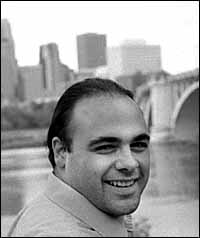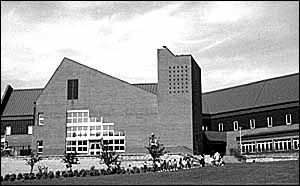Wednesday, April 28, 1999, was an impossibly bright, warm, Autumny day in Minneapolis. But instead of soaking up the sun outside, several hundred city residents gathered in the gymnasiumlike ambiance of the Northeast Armory off Broadway Avenue for cookies, coffee, and an acronym-laden discussion about the fate of the city's Neighborhood Revitalization Program (NRP)--the decade-old project created to move some money and decision-making power from city hall out into neighborhoods.
Brown metal church-basement folding chairs were spread across the gray concrete floor, many of them filled with residents sporting T-shirts declaring their allegiance to this or that corner of the city. Up in front sat a cluster of folks from the Whittier Alliance, all clad in goldenrod shirts and carrying homemade signs, including a hot-pink one emblazoned with: "Tree Plantings Thanks to NRP." In another section, folks from the Powderhorn Park Neighborhood Association were dressed in gray-and-blue shirts, while the Folwell contingent wore deep forest green.
|
Where Has All the Money Gone?
THOSE WHO CRAFTED Minneapolis's Neighborhood Revitalization Program likely never envisioned that four neighborhoods (East Calhoun, East Harriet, Linden Hills, and Lynnhurst) would collectively spend $16,800 for a collection of environmental tips called a "clean water cookbook." Nor would they probably have guessed that some neighborhoods would earmark $1,000 each for radar guns to combat speeding motorists. Or that Victory residents would spend $10,000 to buy band equipment for the Loring School. Or that many neighborhoods would help fund so-called gateway art installations (to the tune of $70,000 in Phillips, more than $13,000 in Kingfield, and $30,000 in East Calhoun).
But they have done all that--and more...
Continues on page 4
|
|

Former Lyndale Neighborhood Association head Joe Barisonzi calls Miller "the best bureaucrat I ever met"
PHOTO BY TEDDY MAKI |
|
The get-together, hosted by the mayor and the city council, was billed as a "community meeting" to address the program's transition into its second decade--officially, if unpoetically, dubbed "Phase II." In her opening remarks, Mayor Sharon Sayles Belton talked about having a "dialogue," and about finding ways to "maximize and leverage resources " so as to "better coordinate NRP with city goals." City council president Jackie Cherryhomes rose to give a boilerplate history of the NRP, from the blue-sky discussions of the late Eighties to the present, before ceding the stage to John Moir, the city's finance officer.
Clad in a tie and dark suit, Moir enumerated a host of financial demands on local government--more police officers, infrastructure improvements, a new library, various development efforts--to make the joyless point that there was only so much money to go around. "I'm not trying to depress people," he offered. "I'm just trying to explain some of the facts."
The remarks--and the information in the cream-colored handouts placed on every chair--hammered home a single point: The NRP had to shape up. The program had fallen short of state requirements, chiefly a mandate that more than half of the money be dedicated to housing. There would need to be rules, the officials argued, to assure that more funds went to that purpose in the program's second decade.
But the audience showed little interest in the vagaries of municipal finance or the finer points of state law. A resident from St. Anthony West defiantly summarized the feelings of many: "We don't need to beg for this money," he declared. "This is our money."
Throughout the two-hour meeting, one bearded, bespectacled guy in the middle of the room didn't say much. He wasn't seated on the dais with Sayles Belton, Cherryhomes, and Moir, and he didn't make any big, windy speeches. He sat on a folding chair; he worked the perimeter. While some of those who brushed past him likely had no idea who he was, many knew him as a savvy ally, formidable adversary, and canny negotiator. Some generals in battle wear uniforms and gold stars; this one wore a short-sleeved plaid shirt.
About a year after the Northeast Armory meeting, the same man arrives five minutes late for a morning meeting, sauntering casually into the NRP office with a friendly "Hey, man" and a handshake. He's wearing a Twins baseball cap, sunglasses, a blue wool scarf, and a brown leather aviator-style jacket. Necktie? Forget it.
The 52-year-old's demeanor is as common and folksy as his name: Bob Miller. His title sounds a little fancier. He is executive director of the NRP, a job he has held since 1992.
The NRP offices are located a several-block hike from city hall, and the distance is symbolic as well as geographic. "It's caught between the community on the one side and the government on the other," says Miller, "and it's not really of either. We do fit in kind of a never-never land."
Miller is not technically a city employee and he does not answer to the Minneapolis City Council. He reports to the 18-member NRP Policy Board, a body that includes representatives from five jurisdictions--the city; Hennepin County; and the school, park, and library boards--as well as members from private foundations, neighborhoods, and the state Legislature. Mayor Sharon Sayles Belton and council president Jackie Cherryhomes sit on the board; Hennepin County Commissioner Mark Stenglein succeeded Cherryhomes as chair in April.
In broader terms, Miller figures that he is accountable to some 55 different elected officials from the various jurisdictions with a stake in the program. He also deals with representatives from 66 neighborhood organizations (the city has 81 officially defined residential neighborhoods, but in the NRP process many of them work together), as well as hundreds of nonprofit agencies and business groups. And every single one them, he'll tell you, has an opinion about him. "I get criticized for just about everything that I do," Miller says. "There's no way I can satisfy everybody out there who has an idea about what I should do or how I should be doing it."
Miller's corner office on the fourth floor of the Crown Roller Mill building overlooks St. Anthony Falls, but he's put a plant in the window to obscure the view, just so folks won't think the perk has gone to his head. "People came in here and said, 'My god, this is spacious, look at this great view!' he recalls. "That's not who I am. I felt embarrassed by it." The space is cluttered in an organized sort of way: Stacks of paper appear to cover every horizontal surface, but they are neat, tidy stacks. A large, gray Rubbermaid dumpster, about half-filled with more paper, sits by the door. Not counting the large
digital watch on his wrist, there are three clocks in Miller's office: a small one mounted on a small wooden stand on his desk, and two on the wall. One is labeled "Bob's Clock" and is running a half-hour slow. It was a gift from his wife. "I'm always late," shrugs Miller.
But many say Miller has an instinct for always knowing what time it is, both politically and strategically. He's "astonished," he says with a broad, easy smile, to still hold a job after eight years. Wryly, he adds, "I don't think anybody would have bet I'd have been here that long." He works assiduously to stay out of the spotlight, preferring to operate behind the scenes. He neither courts nor trusts media attention, figuring it can't do him any good.
Miller's roots in Minneapolis neighborhoods run deep. He grew up in Powderhorn and graduated from Central High School in 1966. His father was a laborer, then a paving foreman for the city; his mother was a teacher. "My dad and my mom were both adamant that you had to contribute something to the community so that it's better off than when you started," he recalls.
Miller went to the University of Chicago, where he earned a B.A. in economics. He proceeded to work for the Veterans Administration in Washington, D.C., and Boston while earning a master's degree in hospital and health-care administration from George Washington University. By his own admission, he was busy climbing the bureaucratic career ladder.

Neighborhood groups have poured their money into thousands of projects, including a brand-new elementary school in Whittier
|
A desire to spend more time with his wife and three kids brought him back to his home town in the Seventies. He has lived in the Fulton neighborhood in the southwest corner of the city since 1977 and helped establish a neighborhood organization there. He worked as a planning supervisor for Hennepin County and eventually headed the Community and Resource Exchange (CARE) program, a joint city-county effort aimed at encouraging neighborhood-based projects. "I've been through every type of bureaucracy you could name," he cracks. Indeed, before selecting Miller the NRP Policy Board debated whether he was too much of an insider for the experimental new program.
But Miller professes that he was already shedding his past as a bureaucrat by the time he took the program's reins. It had dawned on him, he says, that he was out of touch with the proverbial guy on the street: "A lot of the stuff that I was dealing with was removed from any kind of reality." The CARE job "radicalized" him, he says, alerted him to the notion of actually listening to what neighborhood residents had to say.
His first priority at the NRP was to cut through the process-speak and get the ball rolling. The program, he told the Star Tribune at the time, was "an administrative nightmare." He set about getting things organized, holding meetings on topics like "How do you hold a meeting?"

| NEXT PAGE»
| 1 | 2 | 3 | 4 |







